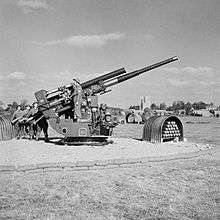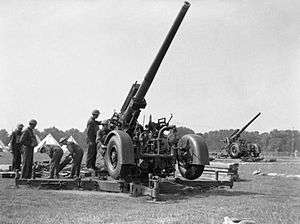QF 3.7-inch AA gun
| QF 3.7-in heavy anti-aircraft gun | |
|---|---|
|
A 3.7-inch gun on a travelling carriage in London in 1939 | |
| Type | Anti-aircraft gun |
| Place of origin | United Kingdom |
| Service history | |
| In service | 1937–present (the Nepalese Army still has 45 in service) |
| Used by | UK and Commonwealth |
| Wars | World War II |
| Production history | |
| Designer | Vickers[1] |
| Designed | 1937 |
| Produced | 1937–1945 |
| Number built | approx. 10.000 |
| Specifications | |
| Weight | 20,541 pounds (9,317 kg) |
| Length | 4.96 m (16 ft 3 in) |
| Barrel length | 4.7 m (15 ft 5 in) L/50 |
| Crew | 7 |
|
| |
| Shell | 28 pounds (13 kg) |
| Calibre | 3.7 inches (94 mm) |
| Carriage | Mobile and static versions |
| Elevation | −5 to +80 degrees |
| Traverse | 360 degrees |
| Rate of fire | 10–20 rpm |
| Muzzle velocity |
Mk I–III: 2,670 ft/s (810 m/s) (new) 2,598 ft/s (792 m/s) (worn)[2] Mk VI : 3,425 ft/s (1,044 m/s)[3] |
| Maximum firing range |
Maximum horizontal: 18,800 feet (5,700 m) maximum slant: 12,000 metres (39,000 ft) ceiling Mk I–II: 9,000 metres (30,000 ft) Mk VI: 13,716 metres (45,000 ft) |
The QF 3.7-inch AA was Britain's primary heavy anti-aircraft gun during World War II. It was roughly the equivalent of the German 88 mm FlaK and American 90 mm, but with a slightly larger calibre of 94 mm. It was used throughout World War II in all theatres except the Eastern Front. The gun was produced in six major variants, two versions (mobile and fixed) and in considerable numbers. The Mk VI ordnance used only with a fixed mounting gave vastly increased performance. It remained in use after the war until AA guns were replaced by guided missiles, notably the Thunderbird, in the late 1950s.
History
Background
During World War I, anti-aircraft guns and anti-aircraft gunnery developed rapidly. The British Army eventually adopted the QF 3-inch 20 cwt as the most commonly used type. Shortly before the end of the war a new QF 3.6 inch gun was accepted for service but the end of the war meant it did not enter production. After the war, all anti-aircraft guns except the three-inch gun were scrapped.
However, the war had shown the possibilities and potential for air attack and lessons had been learned. The British had used AA guns in most theatres in daylight, as well as against night attacks at home. They had also formed an AA Experimental Section during the war and accumulated much data that was subjected to extensive analysis. After an immediate post war hiatus, the army re-established peacetime anti-aircraft units in 1922. In 1925 the RAF established a new command, Air Defence of Great Britain, and the Royal Artillery's anti-aircraft units were placed under its command.
In 1924–5 the war office published the two-volume Textbook of Anti-Aircraft Gunnery. It included five key recommendations for heavy anti-aircraft (HAA) guns:
- Shells of improved ballistic shape with HE fillings and mechanical time fuzes
- Higher rates of fire assisted by automation
- Height finding by long-base optical rangefinders
- Centralised control of fire on each gun position, directed by tachymetric instruments which incorporated the facility to apply corrections of the moment for meteorological and wear factors
- More accurate sound-location for the direction of searchlights and to provide plots for barrage fire
Two assumptions underpinned the British approach to HAA fire. First, aimed fire was the primary method and this was enabled by predicting gun data from visually tracking the target with continuous height and range input. Second, that the target would maintain a steady course, speed and height. Heavy anti-aircraft units were to engage targets up to 24,000 feet (7,300 m). Mechanical, as opposed to igniferous, time fuzes were required because the speed of powder burning varied with height so fuze length was not a simple function of time of flight. Automated fire ensured a constant rate of fire that made it easier to predict where each shell should be individually aimed.[4]
During the 1920s Vickers developed the Vickers Predictor, an electro-mechanical computer that took height and range data from an optical rangefinder, applied corrections for non-standard conditions and was used by its operators to visually track a target, its output predicted firing data and fuse setting via the "mag-slip" electrical induction system to dials on each gun in a battery, the gun layers moved the gun to match pointers on the dials. The three-inch AA guns were modified accordingly.[4]
QF 3.7
In 1928 the general characteristics for a new HAA gun were agreed on; a bore of 3.7 inches (94 mm) firing 25 pounds (11 kg) shells with a ceiling of 28,000 feet (8,500 m). However, finances were very tight and no action was taken until the 1930s, when the specification was enhanced to a 28 pounds (13 kg) shell, 3,000 feet per second (910 m/s) muzzle velocity, a 35,000 feet (11,000 m) ceiling, a towed road speed of 25 miles per hour (40 km/h), maximum weight of eight tons and an into action time of 15 minutes.
In 1934 Vickers Armstrong produced a mock-up and proceeded to develop prototypes of the weapon, which was selected and passed acceptance tests in 1936.[5][6] However, the weight specification was exceeded and the muzzle velocity not achieved. Furthermore, the initial mechanical time fuze, No. 206, was still some years from production so the igniferous No. 199 had to be used, and its lesser running time limited the effective ceiling. Gun production started the following year.
On 1 January 1938, the British air defences had only 180 anti-aircraft guns larger than 50 mm, and most of these were the older three-inch guns. This number increased to 341 by the September 1938 (Munich Crisis), to 540 in September 1939 (declaration of war), and to 1,140 during the Battle of Britain. Production continued until 1945, averaging 228 guns per month throughout the period. Guns were also manufactured in Australia.
Being a high velocity gun, with a single charge and firing substantial quantities of ammunition, meant that barrel life could be short. By the end of 1940 the barrel situation was becoming critical. Some of the substantial numbers of spare barrels required were produced in Canada.
In British service the gun replaced the three-inch AA gun in HAA batteries of the Royal Artillery, almost always in HAA regiments, which were usually in an anti-aircraft brigade. Each regiment usually had three batteries, each of eight guns in two troops. A total of 212 of these HAA regiments, Royal Artillery, and two each of the Royal Marines and Royal Malta Artillery were eventually formed. Other World War II users were India (about 14 regiments), Canada (two or three regiments), East and West Africa (five regiments), and Australia (equivalent of about 13 regiments).
Description

Gun
Two versions of gun were produced. One used a travelling carriage, for use by batteries in the field army. This consisted of a wheeled carriage (Carriage Mk I or Mk III) with four foldable outrigger trails and levelling jacks. The wheels were lifted off the ground or removed when the gun was brought into action.
The other used a travelling platform (Mounting Mk II) with detachable wheels for guns to be used in static positions, but which could be re-positioned. The mounting had a pedestal that was fixed to a solidly constructed, preferably concrete, platform on the ground. In 1944, it was found that a temporary platform built from railway sleepers and rails was adequate for the static guns, making them considerably easier to re-deploy without the cost and delay of constructing new concrete platforms. These were known as Pyle platforms, after the head of Anti-Aircraft Command, General Frederick Alfred Pile.[7]
In both cases the saddle rotated 360° on the carriage or pedestal and provided elevation up to 80°. An AEC Matador was the normal gun tractor.
There were six marks of ordnance (the barrel and breech assembly) and a few marks of carriage of both versions, some using letter suffixes. The carriage included the recoil system, laying arrangements, fuse setting and loading machinery.
The Mk IIC mounting enabled fully automatic engagements, apart from putting shells into the feed to the machine fuze setter.
Ammunition
Initially there were HE and shrapnel shells, both fitted with a time fuze. Fuze No.199 was igniferous (i.e. powder-burning) with a maximum running time of 30 seconds. Fuzes No. 106 and 107 were mechanical time fuses; both proved unsatisfactory. Fuze No. 208, with a maximum running time of 43 seconds, became the standard fuze.
A major advance in 1942 was the introduction of Machine Fuze Setter No. 11, on Mounting Mk. IIC and Carriage Mk. IIIA. This raised the rate of fire to 20 rounds per minute.
Ordnance variants

Mk I
Monobloc barrel.
Mk II
Barrel changed to loose liner.
Mk III
The Mk III started as a combination of the Mk I breech with the Mk II barrel.
Mk IV
A prototype development of the 3.7-inch gun using the QF 4.5-inch naval gun Mk V barrel with a liner to give a gun using a 4.45 inches (113 mm) size cartridge case to drive the 3.7 inches (94 mm) shell. The barrel wear proved excessive and it was dropped in favour of the Mk VI.
Mk V
Similar to the Mk IV. Also dropped in favour of the Mk VI.
Mk VI
Like the Mk IV this was based on the 4.5 inch barrel design lined down to 3.7 inches, and using the 4.5 inch size cartridge. However, Colonel Probert changed the barrel to have gradual rifling: the rifling groove depth decreased to zero over the last five calibres of the barrel before the muzzle. This smoothed the two driving bands of a new design shell giving reduced air resistance and hence better ballistic performance, and causing far less barrel wear. The maximum ceiling for the gun was about 15,240 metres (50,000 ft). It was mounted on the Mounting Mk IIA and therefore deployed in static emplacements only. In service from 1944 to 1959.
Performance
Gun effective ceiling varied depending on the predictor and fuse. The Mk VI ordnance significantly increased the potential effective ceiling. The British definition of effective ceiling at the start of World War II was “that height at which a directly approaching target at 400 mph can be engaged for 20 seconds before the gun reaches 70° elevation”[8]
- Mk III Ordnance, Predictor No 1 and Fuze No 199: 23,500 feet (7,200 m)
- Mk III Ordnance, Predictor No 1 and Fuze No 208: 24,600 feet (7,500 m)
- Mk III Ordnance, Predictor No 2 and Fuze No 208: 25,300 feet (7,700 m)
- Mk III Ordnance, Predictor No 11 and Fuze No 208: 32,000 feet (9,800 m)
- Mk VI Ordnance, Predictor No 11 and Fuze No 208: 45,000 feet (14,000 m)
Field and anti-tank

Like other British guns the 3.7 had a secondary anti-tank role. This meant that if the gun position came under tank attack it would engage the tanks. However, during the campaign in North Africa, the shortage of capable anti-tank guns led to some agitation to use the 3.7 in a primary anti-tank role, i.e. deployed specifically for anti-tank defence.
Guns had their sighting arrangements improved to enable better anti-tank shooting. However, the 3.7 was only used in the anti-tank role in one or two emergencies. The arrival of the smaller 76 mm (3-inch) calibre 17-pdr anti-tank gun in late 1942 made a primary anti-tank role irrelevant for the 3.7 but if, unusually, they were deployed in a forward area then they could have a secondary anti-tank role.
The 3.7 was inherently unsuitable as an anti-tank gun. It was big and heavy, two tons heavier than the German 88, making it tactically unsuitable for use in forward areas. Additionally, HAA regiments equipped with the 3.7 were relatively few in number in the field army and controlled by corps or army HQ, or at even higher level HQs, and command of them was not often devolved to the commanders at divisional level where the anti-tank role might be required. Prolonged firing at low elevations (not part of the original specification) also strained the mounting and recuperating gear.
The guns were used in the field artillery role quite extensively in the second half of the war in Italy, north-west Europe, Burma and the south-west Pacific. Batteries were issued with the necessary fire control equipment. Counter-battery or counter-mortar fire was the usual role. However, their HE ammunition seems to have always been fuzed for airburst; this means maximum ranges were limited to 9,200 yards (8,400 m) with the No. 199 fuze and 16,200 yards (14,800 m) with the No. 208 fuze.
A gun developed from the 3.7-inch gun was also used to arm the Tortoise heavy assault tank, where it was designated the Ordnance QF 32 pounder. The Tortoise, which is best described as a self-propelled gun, never saw service.
Operators
-
 Australia
Australia -
.svg.png) Belgium: 12
Belgium: 12 -
 Canada
Canada -
 Cyprus
Cyprus -
 India
India -
 Ireland
Ireland -
 Israel
Israel -
 Malta
Malta -
 Nepal: 45 still in service
Nepal: 45 still in service -
 New Zealand: Royal New Zealand Artillery
New Zealand: Royal New Zealand Artillery -
.svg.png) Union of South Africa
Union of South Africa -
 Socialist Federal Republic of Yugoslavia
Socialist Federal Republic of Yugoslavia -
 United Kingdom
United Kingdom -
 Poland as part of the Polish II Corps within the British 8th Army
Poland as part of the Polish II Corps within the British 8th Army
Weapons of comparable role, performance and era
- 8.8 cm Flak 18/36/37/41 : contemporary German anti-aircraft gun, firing a lighter (20 pound) shell
- 90 mm Gun M1 : contemporary US anti-aircraft gun, firing a lighter (22 pound) shell
- Cannone da 90/53 : contemporary Italian anti-aircraft gun, firing a lighter (23 pound) shell
- 85 mm air defense gun M1939 (52-K) : contemporary Soviet anti-aircraft gun, firing a lighter (20 pound) shell
References
- Notes
- Bibliography
- Hogg, Ian V. 1998. "Allied Artillery of World War One" Malborough: The Crowood Press ISBN 1-86126-104-7
- Routledge, Brigadier NW. 1994. "History of the Royal Regiment of Artillery – Anti-Aircraft Artillery 1914–55". London: Brassey's ISBN 1-85753-099-3
External links
| Wikimedia Commons has media related to QF 3.7 inch AA gun. |
